Arc de Triomphe
Napoleon's Monument to His Army
Arc de Triomphe Hours and Admissions
Metro: Charles de Gaulle-Etoile
Arrondissement: 8eme
Go Here For Hotels In This Area
After Napoleon's greatest victory in 1805, at the Battle of Austerlitz in what is now the Czech Republic, he told his Grand Army, "You will return home through arches of triumph!"
In 1806, Napoleon commisioned Jean Françoise Chalgrin to design what is now credited as the world's largest triumphal arch.
Completed in 1836, fifteen years after his death, Napoleon passed through this arch just once, December 15, 1840, when his ashes were returned from the island of Saint Helena where he had spent the last six years of his life in exile. He was then placed in Les Invalides until 1861 while the Eglise du Dome was being transformed from a church to a mausoleum, where he was then entombed.
However, since it's completion millions of tourists have passed through the Arc, making it a "must do" on your list of things to do in Paris.
The Arc has a height of 50 meters (164 feet), a width of 45 meters (148 feet), and a depth of 22 meters (72 feet). Each of its four pillars is adorned with sculptures.
The Arc has a height of 50 meters (164 feet), a width of 45 meters (148 feet), and a depth of 22 meters (72 feet). Each of its four pillars is adorned with sculptures.
On the north-east pillar is the most famous of these sculptures called, "The Departure of the Volunteers", or more commonly called, "La Marseillaise", designed by Francois Rude. On the south-east pillar is the, "Triumph of 1810", designed by Cortot. The north-west pillar offers the sculpture called, "The Peace of 1815", and on the south-west side is, "The Resistance of 1814", both of which were designed by Etex.
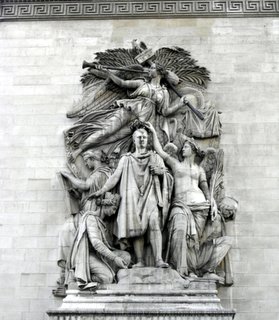
On the interior walls of the main arch are inscribed the names of the lesser victories of Napoleon. The major victories are inscribed along the the roof line of the arch.
Engraved on the interior walls of the two lesser arches, on both sides of the main arch, are the 558 names of Napoleon's generals. The ones that are underlined are those who died in battle.
The many other bas-relief sculptures found on the Arc represent important scenes in various battles.
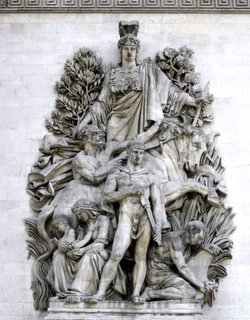
On November 11, 1920, Armistice Day, the Unknown Soldier from WWI was entombed at the foot of the Arc de Triomphe. On every Armistice Day since, the French President has laid a wreath at this tomb. In 1923, the Eternal Flame was lit.
Embedded in the cement beneath the arch are plaques commemorating the lives lost in different wars, including those in Indochina, Tunisia, Morocco, Korea and World Wars I and II.
There are also plaques commemorating the return of the regions of Alsace and Lorraine to France on November 11, 1918, and the Proclamation of the Republic.
The speech of General Charles de Gaulle, given on radio while in exile on June 18, 1940, is also set in bronze here.
The Arc de Triomphe sits at the top of the small hill Chaillot. From the ground level one can look down the Avenue des Champs-Elysées and see the gold-tipped Obelisk of Luxor, marking the Place de la Concorde. Further on is the Arc de Triomphe du Carrousel and the Louvre Palace.
Looking in the opposite direction, west, down the Avenue de la Grande Armée, one can see the Grande Arche de La Défense.
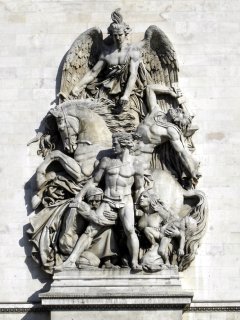
Radiating out in a star pattern (which is why this traffic circle, one of the largest in the world, is called Place de l'Etoile [Star Plaza]) are 10 other streets. All of this is viewed more dramatically from atop the Arc.
There are 2 ways to get to the Arc de Triomphe and they are both tunnels that go beneath the very busy traffic circle.
The most used tunnel access is on the north-east corner of the Avenue des Champs-Elysées. It is distinguished from the Metro station access, also on this corner, by a sign indicating that it leads to the Arc de Triomphe.
The other tunnel access is on the north-west side of the Arc, on the north corner of Avenue de la Grande Armée.
These tunnels are open until 10:30 p.m. every night.
If one wants to climb the stairs to the top of the Arc, or take the elevator provided for those unable to use the stairs, a ticket must be purchased.
The ticket booth for these tickets is located in the entrance tunnel, at the stairs leading up to the Arc. The top of the Arc de Triomphe receives more than 600,000 visitors per year.
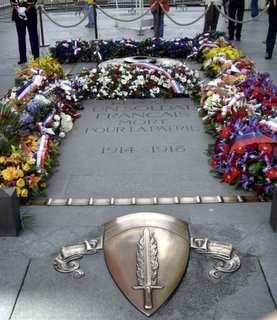
Arc de Triomphe Hours and Admissions
- The top of the Arc is open from 10 a.m.-10:30 p.m. during winter months and until 11 p.m. during the summer, with the last entry being 30 minutes prior to closing.
- Tickets are 9.50 euros for adults, 6 euros for ages 18-25, and free for those 17 and under when in company with their family, free for EU citizens under 26 years old and for disabled persons and a companion.
Return to Top of Arc de Triomphe Page
Private Tours
| Paris Introduction Tour | Paris Islands Tour | Paris Passages Tour |
| Trocodero-Eiffel-Invalides | Marais Tour | Montmartre Tour |
| Latin Quarter Tour | Paris Markets Tour | Paris Churches Tour |
Booking.com
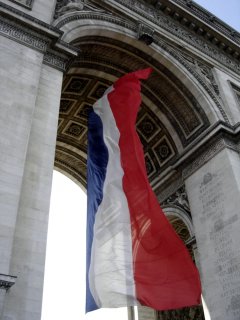
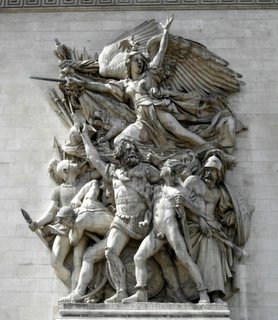
New! Comments
Have your say about what you just read! Leave me a comment in the box below.